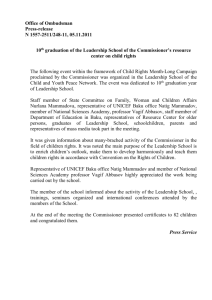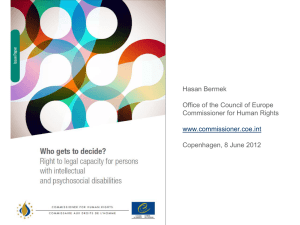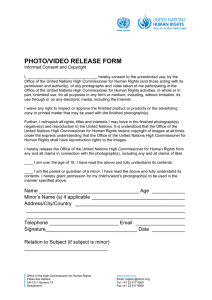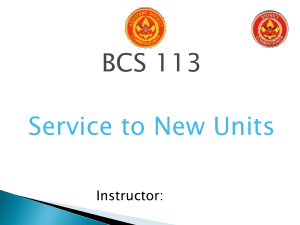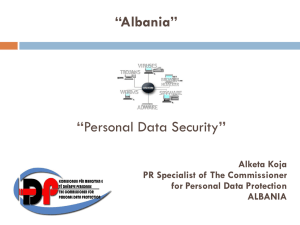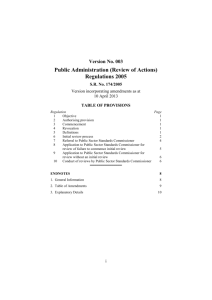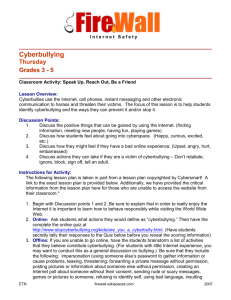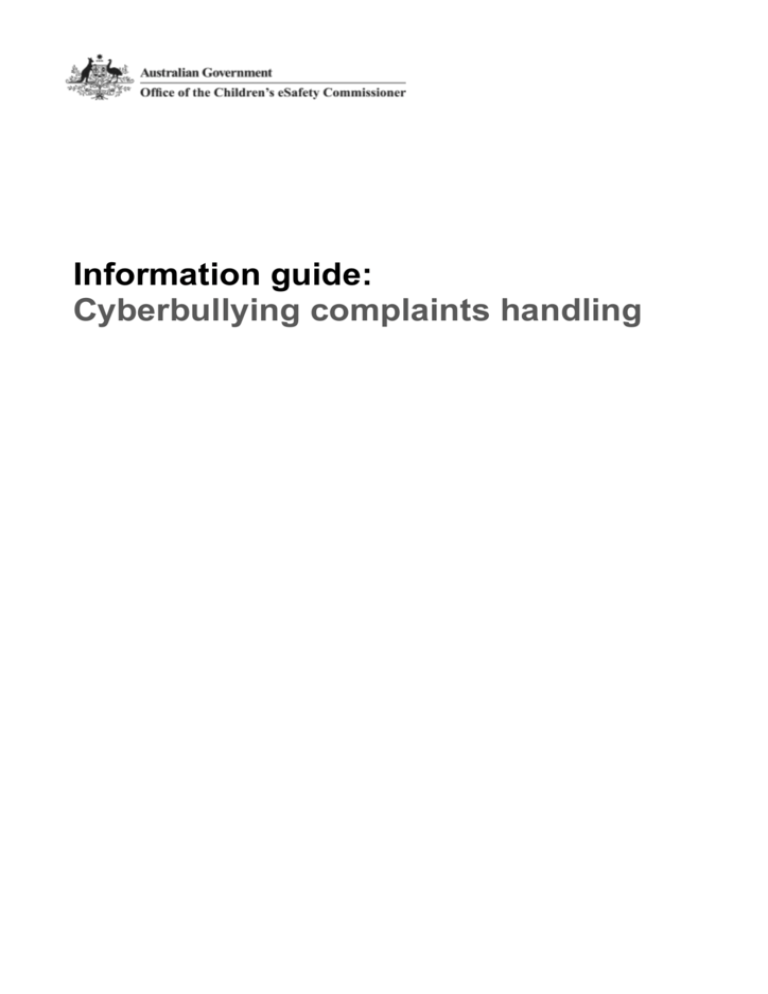
Information guide:
Cyberbullying complaints handling
www.esafety.gov.au
Canberra
Red Building
Benjamin Offices
Chan Street
Belconnen ACT
PO Box 78
Belconnen ACT 2616
T +61 2 6219 5555
F +61 2 6219 5353
Melbourne
Level 32
Melbourne Central Tower
360 Elizabeth Street
Melbourne VIC
PO Box 13112
Law Courts
Melbourne VIC 8010
T +61 3 9963 6800
F +61 3 9963 6899
Sydney
Level 5
The Bay Centre
65 Pirrama Road
Pyrmont NSW
PO Box Q500
Queen Victoria Building
NSW 1230
T +61 2 9334 7700
F +61 2 9334 7799
Copyright notice
http://creativecommons.org/licenses/by/3.0/au/
With the exception of coats of arms, logos, emblems, images, other third-party material or devices protected by a trademark, this content is licensed under the
Creative Commons Australia Attribution 3.0 Licence.
We request attribution as: © Commonwealth of Australia (Office of the Children’s eSafety Commissioner) 2015.
All other rights are reserved.
The Office of the Children’s eSafety Commissioner has undertaken reasonable enquiries to identify material owned by third parties and secure permission for its
reproduction. Permission may need to be obtained from third parties to re-use their material.
What does the Children’s eSafety Commissioner’s office do?
The Commissioner is an independent statutory office created within the Australian Communications
and Media Authority by the Enhancing Online Safety for Children Act 2015 (the Act). The
Commissioner has a wide range of functions and powers to enhance online safety for Australian
children.
A key objective of the Commissioner’s office is to reduce Australian children’s exposure to
cyberbullying. In fulfilling this the Commissioner will take a preventative approach to encourage and
empower children and their carers to take positive measures to address cyberbullying behaviours as
they first arise.
The Commissioner recognises the importance of Australian children having the knowledge and skills
to engage appropriately and safely with others online. This is an important life skill for participating in
the digital environment and applies equally to children who find themselves victims of cyberbullying
and children who engage in cyberbullying behaviours.
The Office of the Commissioner administers a complaints system for cyberbullying material targeted at
an Australian child and ensures cyberbullying material is removed as quickly as possible.
Other functions include promoting and co-ordinating activities relating to online safety for children in
Australia and administering the online content scheme under Schedules 5 and 7 to the Broadcasting
Services Act 1992.
The Commissioner’s general approach to cyberbullying complaints
The Commissioner has the power to investigate complaints and conduct investigations into
cyberbullying material as he thinks fit. This includes balancing a person’s right to freedom of
expression to the extent necessary with the rights or reputation of the child at whom the material is
targeted.
What action the Commissioner will take will depend on each individual case.
The Commissioner will look to equip children and school communities with strategies and practical
advice on how to respond appropriately when confronted by cyberbullying. This also includes advice
and guidance on appropriate online behaviour. The Commissioner will work closely with schools,
enforcement agencies and other key stakeholders to best achieve this.
In addition, the Commissioner will work with Kids Helpline, a leading provider of both online and phone
counselling for young people, to provide 24-hour psychological support to children who have been
cyberbullied and need someone to talk to. It is important that cyberbullied children feel they are not
alone with this experience.
When the Commissioner makes the decision to investigate a complaint, the Commissioner will work
with social media services to get cyberbullying material removed quickly. This may also include the
referral of certain complaints to schools or police to assist in the resolution of a matter.
The Commissioner will take a rights-based approach specifically applicable to children where:
the best interests of the children involved are of paramount
consideration,
children’s differing stages of development and understanding are taken
into account, and
the emphasis is on diversion and education.
Page 1
Who can lodge a complaint with the Commissioner about
cyberbullying material?
A complaint to the Commissioner can be made by an Australian child who is (or was) the target of
cyberbullying material provided on a social media service or a relevant electronic service. Under the
Act an Australian child is defined as a child under 18 years old who is ordinarily resident in Australia.
A parent or guardian of the child, or a responsible person authorised by the child, may also make a
complaint on the behalf of an Australian child who is the target of cyberbullying.
Complaints about material targeted at a person above the age of 18 cannot be considered.
The only exception to this is where the complainant makes a complaint within 6 months of their
eighteenth (18th) birthday.
Complaints about cyberbullying targeting adults
Adults who wish to report cyberbullying can lodge a complaint with the Australian Cybercrime Online
Reporting Network (ACORN)
When will the Commissioner investigate?
Under the Enhancing Online Safety for Children Act 2015 (the Act) the Commissioner has broad
discretion as to whether a complaint will be investigated and how that investigation will be conducted.
Each complaint will be assessed on a case by case basis having regard to whether the complaint
satisfies the relevant provisions of the Act.
As a general guide, a person can make a complaint to the Commissioner where they believe that an
Australian child is (or was) the target of cyberbullying material and:
i)
the material is provided on a social media service or relevant
electronic service,
ii)
an ordinary reasonable person would conclude that the material was
intended to have an effect on a particular Australian child, and
iii)
that the material would be likely to have a seriously threatening,
seriously intimidating, seriously harassing or seriously
humiliating effect on the Australian child at whom the material is
targeted.
How does the Commissioner decide if material is cyberbullying
material?
The Commissioner’s role is to investigate complaints about cyberbullying where the material
complained about is likely to seriously threaten, intimidate, harass or humiliate a particular Australian
child. The Commissioner only needs to be satisfied that the material is likely to have one or more of
these effects on the balance of probabilities (that is, more likely than not).
The Commissioner adopts a flexible approach so that children who are genuinely affected by
cyberbullying material are protected. This approach involves looking at a range of characteristics of
both the individual child and the relevant material.
Page 2
Characteristics of an individual child include the child’s background and particular circumstances, any
vulnerabilities of the child, and the relationship between the child and the person posting the material.
With cyberbullying material, the Commissioner will look at things like the language used, the impact of
any audio or visual material, the sensitivity of the material, the number of potential views, and how
often the material was posted.
Material which is merely offensive or insulting is unlikely to fall within the scheme.
Can I complain about being cyberbullied on any site or app?
The Commissioner can accept complaints about cyberbullying material targeting an Australian child
posted on a wide range of digital platforms. The Act defines a social media service very broadly as a
service that: has the sole or primary purpose of enabling online interaction (including enabling endusers to share material for social purposes) between two or more end-users, allows end-users to link
to or interact with some or all of the other end-users, and allows end-users to post material on the
service.
This broad definition includes:
social networking sites and apps
blogging sites and apps
messaging apps which allow content to be included with messages
photo and video sharing sites and apps.
In addition, the Commissioner can accept complaints regarding children who are or have been
cyberbullied on email, instant messaging services, phone based SMS texts and MMS pictures and
videos, chat services (phone or online-based) and online games.
How do I complain to the Commissioner?
Complaints can be made using the online cyberbullying complaint form on the Commissioner’s
website.
It is very important that a complainant provide as much evidence as possible to support their claim
about cyberbullying. The Commissioner must see the actual material to be able to make decisions
about whether or not to investigate a complaint and the appropriate action to take to resolve
complaints.
Evidence is accepted in the form of most file-types. To assist in the rapid removal of content a
complainant must include a link to the content where possible. For provisions of images or text from
websites or mobile apps, providing URLs is recommended. Screenshots or snips from desk-top
computers, laptops, tablets and smartphones are also accepted. For onscreen content on nonsmartphones taking a digital photo of the screen and uploading that photo is the easiest way to
provide evidence. The website gives information on how to gather and provide evidence on a range of
electronic devices.
The complainant will receive email confirmation that their complaint has been received. The
confirmation email may also contain information on self-help strategies and access to support services
such as the Kids Helpline. Practical advice on how to deal with and respond to cyberbullying more
broadly may also be provided.
Page 3
What priority will my complaint be given and how long will the
complaint process take?
All complaints received by the Commissioner will be prioritised having regard to the risk of harm to the
child targeted by the cyberbullying.
The Commissioner will notify the complainant once their complaint is received and will inform the
complainant whether or not their complaint will be investigated.
Once an investigation is commenced the amount of time to complete an investigation will vary. This is
likely to be dependent on the action the Commissioner decides to take to resolve the complaint
including which of the two complaint resolution schemes that the Commissioner oversees will apply to
the complaint: the Tier scheme, or the end-user notice scheme.
The Tier scheme
The Tier scheme has been set up to get harmful cyberbullying material taken down as quickly as
possible. Services that participate in the Tier scheme are listed on a public register on the
Commissioner’s website.
If a complaint falls under the Tier scheme it is anticipated that the Commissioner will be able to act as
quickly as 48 hours in some cases from the time a matter is referred to the Commissioner.
If the cyberbullying material is on a Tier 1 or Tier 2 social media service, a complainant must first make
a complaint to that service using the service’s complaints handling tools. The service generally has 48
hours to remove material in response to a complaint.
If a complainant is not satisfied with the resolution from the Tier 1 or Tier 2 service, then they may
complain to the Commissioner.
A complaint to the Commissioner about material on a Tier 1 or Tier 2 service must include evidence
that a complaint was first made to that service about the cyberbullying material. This is in addition to
providing evidence of the actual cyberbullying material that is the subject of the complaint.
The end-user notice scheme
Under this scheme, the Commissioner has the power to give a notice to a person posting the
cyberbullying material (the end-user) to remove the material, refrain from posting material which
targets the complainant, or apologise.
Investigations of cyberbullying material under the end-user notice scheme are likely to require more
time. Matters that the Commissioner will need to be satisfied of under the end-user notice scheme
include:
the identity of the end-user who posted the cyberbullying material, and
whether the issuing of a notice is an appropriate action to take in the
circumstances.
Matters that the Commissioner may take into account in determining whether it is appropriate to give
an end-user notice include: the apparent age of the end-user posting the cyberbullying material;
whether the behaviour and its impact on the child are ongoing; the content of the material; whether
there have been previous complaints involving the same child and end-user; and the prospect of the
relevant school addressing the behaviour.
Referral by the Commissioner to a school in many circumstances may be the most effective and
proportionate action to resolve a complaint.
Page 4
If material is considered to be so serious that it merits escalating to law enforcement agencies the
Commissioner will look to refer the matter as quickly as possible.
Are complaints kept private?
All personal information provided to the Commissioner will be kept in accordance with the
Commissioner’s privacy policy and the Privacy Act 1988.
However, the Commissioner has broad powers under Part 9 of the Act to disclose information to
certain authorities, teachers or school principals, and parents or guardians. This is intended to assist
the Commissioner in the resolution of complaints. The Commissioner may, by writing, impose
conditions that need to be complied with in relation to any information disclosed.
Review of a decision
Under section 88 of the Act a decision by the Commissioner to refuse to give the provider of a social
media service a social media service notice that relates to material provided on the service is
reviewable by the Administrative Appeals Tribunal. An application for review can only be made by: the
person who made a complaint under section 18, the person who was the target of the material
provided on the service, or a person who has the consent of the target of the material.
Page 5

